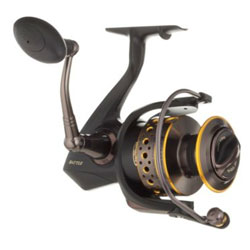
We choose many things about our saltwater fishing. The reel and rod combination is just one, but it is one of the most important. Off the shelf "big box" combos sell well, but for the most part, they are illogically sized and usually what I call throw-away quality. My dad always used to say, "ou get what you pay for." In this department, he was right.
So, should I use a spinning outfit or a bait casting outfit? That's the question, and the answer is not all that simple. It depends on a lot of variables — some of which are purely personal choice!
Baitcasting Reel
 |
| Casting accuracy with saltwater baitcasters takes a lot of practice. |
Let's face it, baitcasters are difficult at best to master. Casting accuracy with these conventional reels takes a lot of practice. The good old "professional overrun" (pronounced backlash) can become a deterrent to even the most persistent angler.
Today's baitcasters come in a variety of sizes and with bells and whistles that Mr. Shakespeare and Mr. Pflueger never dreamed of back in the days of the old President and Supreme reels. The magnetic spool stops, star drags and specially designed spools on today's reels help us cast better with fewer backlashes.
In a saltwater environment, a lot of our decision is based on what species of fish we plan to pursue. Big fish, big rod and reel — that's the general equation. So, when it comes to baitcasting in saltwater, we are generally talking about fish less than 20 pounds. I'll get criticized for that number from readers who have caught much larger fish on a baitcaster, but I can assure you they were not really pursuing larger fish with a small outfit. Some awfully big fish have been caught on baitcasters but usually not by design.
Saltwater baitcasters are larger and beefier than their freshwater cousins. They will have saltwater resistant components and heavier drags. Some of them are capable of handling 30-pound test monofilament line. But realize that the larger the rod and reel combination, the more difficult it is to cast.
All rods have a backbone. When they're being built, the rod crafter finds the backbone on the rod blank he is using and wraps the eyes on the rod along that backbone. Baitcasting rods will, by design, have a stiffer backbone than spinning rods. The backbone on a well-built baitcasting rod will be along the top of the blank where the eyes are mounted. On a spinning rod, the eyes are also mounted along the backbone, but now the backbone is on the bottom of the rod blank. This backbone assists in the resistance that the rod provides to a fighting fish. Inexpensive, mass-produced rods will usually not be built with the eyes on the backbone. That takes time, and time is money.
So we have baitcasters: hard to cast, hard to control, and generally designed for smaller saltwater fish. When the fish you target are over 20 pounds, your gear will generally change to larger, conventional reels and rods, specifically designed for larger fish.
Spinning Reel
 |
| Saltwater spinning reels are popular because of their ease of use. |
That said, what about spinning gear? In the 1950s, some strange looking reels came to America from countries like France. These new reels would eventually revolutionize the fishing world. They were easy to use, easy to learn, and perhaps the best part — they would not backlash! They were the new spinning reels.
A stationary, vertical spool with a pick-up arm allowed the line to flow off the reel during a cast. The pick-up arm — later named a bail — rotated with every turn of the handle to wind the line back on the spool — shades of an old spinning wheel, hence the name!
Spinning reels gained popularity because of their ease of use. Casting is generally far more accurate, particularly for the occasional angler. And that lack of any backlashes proved to be a huge selling point.
In general, spinning reels can and are built for lines as heavy as 50-pound test. A matching rod, built to handle that 50 pound line, makes an outfit that is comparatively easy to cast, fairly accurate and very easy to use. A conventional rod and reel combination is extremely difficult to cast and when a long cast is attempted, it usually is very inaccurate and result in a backlash.
Heavy spinning outfits are even used for light trolling. Lots of mahi mahi are boated with 30-pound class spinning gear. But heavy is a relative term. For tackle heavier than 50-pound line, spinning gear simply will not hold up. The rod strength required would make the outfit almost unusable. I liken it to trying to cast a broom stick.
Bottom Line
So the bottom line weighs in with some simple comparisons. If you are a novice or an infrequent angler fishing, opt for spinning gear. It will be easy to use, good for smaller fish and will provide a high level of casting accuracy. Make sure you choose a matched rod and reel combo such as those found in the Bass Pro Shops catalog, so that your rod and reel can work together in the most efficient manner.
If, however, you want to chunk artificial lures and you are an experienced angler, baitcasting outfits can provide more backbone for hook setting and more action on your lures than spinning gear. Once again, a matched setup will provide you the best possible arrangement and will get the most out of your fishing day.
And for those of us who fish for the smaller fish, it really does not matter to the fish which type of gear you use. Choose and fish with what makes you the most comfortable. Which outfit do I use? Well, it depends...
- 43263 views

